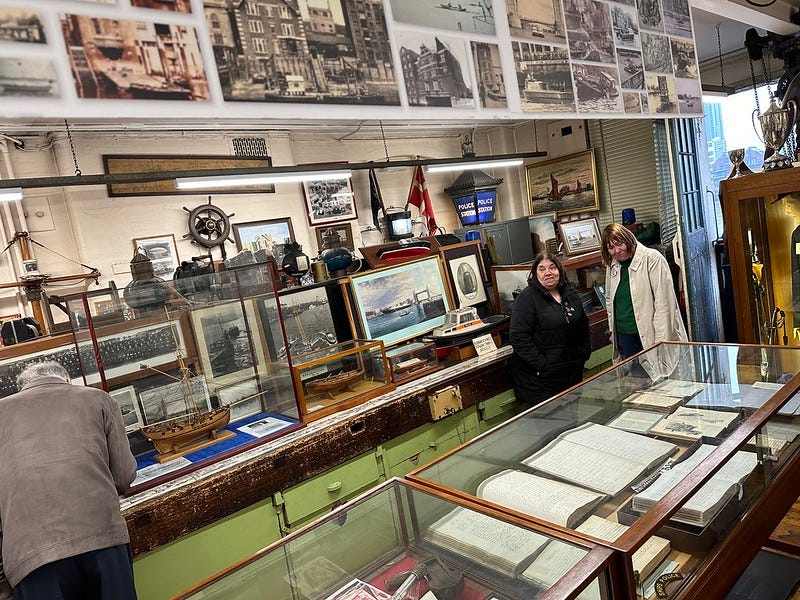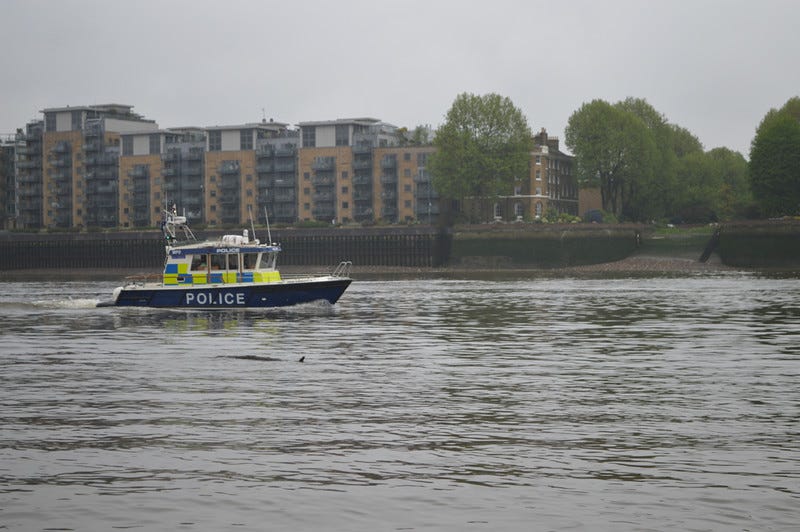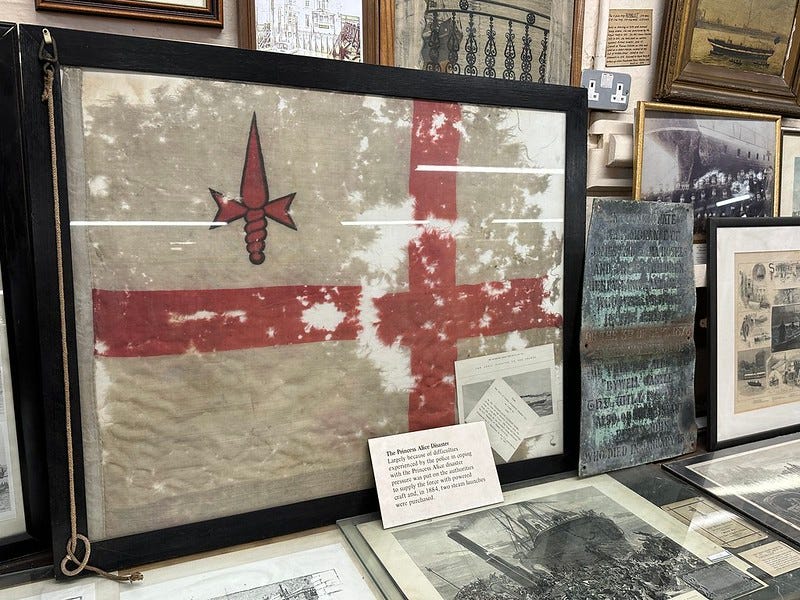Welcome to Londonist: Time Machine, the leading Substack for London history. This Friday email is usually part-paywalled, but I’m leaving it off once again this week, so everyone can comment on plans for 2025.
Do you like exploring small museums and little-known spaces? Part of the joy of writing this newsletter is that I get to share my favourite London discoveries with a receptive audience. Usually, it’s by the convenient if only partially satisfying medium of the computer screen. But not always.
Since Day 1, I’ve wanted to pilot Londonist: Time Machine through the offline world; into the streets and museums and hidden quarters of the real city. We’ve done it a few times already with a few site visits for paying subscribers: a virtually unknown ephemera museum, a tour of the Cinema Museum, and a satisfying dunk into the Bermondsey Biscuit Museum. Last week, a small group got to go inside the River Thames Police Museum in Wapping (see below), which is normally closed to the public. We’ve also enjoyed occasional meet-ups in historic London pubs.
I’m keen to run more of these events in 2025, especially to say thank you to subscribers who’ve gone the extra step and taken a paid subscription to Londonist: Time Machine. I’ve not booked anything in yet, but you can read more about my ideas further down. First, the History Radar, and then a few paragraphs on our most recent site visit.
History Radar
Upcoming events of interest to London history fans.
💄MEDIEVAL MAKEOVER: On 18 November, Join award-winning journalist Anita Bhagwandas, and historians Professor Jill Burke and Amber Butchart at the British Library for Medieval Get Ready With Me. This panel event delves into the history of cosmetics and medieval beauty practices, with insights from experts and interactive makeup trials showcasing how beauty standards have evolved. This event is linked to the current Medieval Women: In Their Own Words exhibition.
🎞️ 1980S: Opening 21 November, The social and political change of the ‘80s are the subject of a new photography exhibition at Tate Britain. View the work of a diverse community of photographers, collectives and publications, working against the backdrop of race uprisings, the miners' strikes, section 28, the AIDS pandemic and gentrification. Runs until May 2025.
💷 BANK LATE: The wonderful Bank of England Museum stay open late on 21 November. It’s a chance to explore the displays after work, but also to hear a talk by Clare Cowan on the interplay and relationship between the Bank of England and Parliament. And you won’t have to spend a single bank note as it’s free.
🌳 FREE GARDEN ENTRY: Visit the Hampton Court Palace gardens for free on the weekend of 23-24 November, as the usual entry fee is dropped for an open weekend. The Great Fountain Garden, Kitchen Garden and Pond Garden are among the areas included, though you'll still need a paid admission ticket if you want to visit the palace itself, the Maze, or the Magic Garden Playground, as well as the ice rink, which opens this week. There is no more historic place to skate than this.
🚶🏽♀️➡️QUEER HISTORY WALK: Join a London Museum Docklands guide on 23 November for a walking tour focusing on London's queer history, revealing hidden stories of queer people who have lived in the capital, since the city was founded.
🕍 DULWICH COLLEGE: A rare chance for the public to see inside Dulwich College on 24 November, as the Barry Buildings, cloisters and courtyards host 120 stalls for its annual Christmas fair.
🔥 GAS LAMPS: Tis the season to appreciate London’s remaining gas lamps, still fairly common in Westminster and Covent Garden. Jane Parker puts on regular tours of these areas, while exploring the history of gas lighting — an invention that transformed city life when it was first introduced from the early 19th century. The tours run on several dates throughout winter, including 23 and 26 November.
⛪️ ST AUGUSTINE'S TOWER: Like to get up high and see London from different viewpoints? Ever scaled the tower of St Augustine's Church in Hackney? It's free to do so on the last Sunday of each month (except December), which happens to be 24 November.
🍗 GEORGIAN DINING ACADEMY: Star in your own period drama (without the drama but with lots of nice food) by attending the Georgian Dining Academy. Dress up all Regency and get over to Ye Olde Watling in the City of London for “a three-course supper, entertainment and dashes of history of the City and the Georgians throughout the evening, with music, poetry and song. The rooms are candlelit, so most atmospheric”. It’s the Academy’s 10th anniversary, so all the more special. Costumes are encouraged but not mandatory. Book ahead for 5 December.
Inside the Thames River Police Museum
Leading 15 readers into an operational police station was not on my bingo card when I started writing Londonist: Time Machine. But here we are, early November 2024, strolling into the cop shop in Wapping. Nobody is in trouble. We’re here to say ‘ello, ‘ello, ‘ello to the in-house museum.
Wapping is home to the world’s first police force, at least according to some definitions. A leading advocate of that claim is Rob Jeffries, the voluble copper-turned-curator who heads up the Thames River Police Museum. In a scintillating introductory talk, Rob tells us how the force was set up in 1798 to prevent crime on London’s docks. Two-and-a-quarter centuries later, the river police still operate from the same buildings.
The aquatic constabulary has a storied history. They’ve patrolled the Thames through centuries of change. These buoyant bobbies knew the river when it was thick with merchant vessels. They’ve witnessed the coming of the steam ships, and the challenges of war. They’ve tackled appalling disasters, such as the sinking of the Princess Alice in 1878, which killed hundreds of people, and the more recent Marchioness Disaster, whose loss claimed 51 lives in 1989. The force is still strong today, with the fastest boats on the river.
This torrent of history is on display around the one-room museum. Here we find a grappling-hooked rope ladder for boarding suspicious vessels (it takes years of training to use, apparently). There we spy items of uniform, venerable truncheons and an early mobile phone used by the police in 1987. They even have a piece of the Princess Alice, a tattered ensign rescued from the feculent waters of Tripcock Ness. That most awful of shipwrecks was a turning point for the river police. They were granted two steam launches shortly after the disaster, to help speed officers along the river.
There’s so much to see here, but the real treasure is Rob himself. A veteran of the force, though long retired into museum stewardship, he delivers on of the best London monologues I’ve ever witnessed. Ask him to tell you the one about the time a Thames Clipper went rogue after midnight…
You can’t just wander into the Thames River Police Museum. It’s group bookings only, or the very occasional open day. But this event was so over-subscribed that I’ll be organising a return visit in 2025 for paid subscribers. Speaking of which…
Site visits for 2025
We’ve enjoyed some memorable site visits over the past year, but I’m very keen to up the game. Everyone enjoys them, myself included, and it’s a good to say thank-you in person. You’ve all been so supportive of this newsletter.
Most of our visits are likely to be small museums. London has many. If you want an idea of just how many, here’s a chart that I put together a few years back. It’s a little out of date (e.g. Museum of London is now closed), but essentially still useful.

A few that catch my eye on there as places we might like to visit:
Eel Pie Island Museum (brilliant for the history of music in that part of London)
Boston Manor House (West London Jacobean mansion, which I’ve not visited since its recent refurb.
Bethlem Museum of the Mind (I’ve never been!)
Battle of Britain Bunker (again, I’ve never been!)
Crossness Pumping Station (amazing)
But I’d love to hear where you’d like to go. In most cases, site visits will be for paying subscribers only, but we might open it out in some cases.
A few other ideas
We’ll also be doing more “drinks in historic pubs” evenings. These have been such fun. No agenda. Just a simple gathering of anyone who wants to come along, in an historic London pub, to natter about London history. So far we’ve tackled The George in Borough, Ye Olde Cock and Ye Olde Cheshire Cheese in Fleet Street, the Cittie of Yorke and Ye Olde Mitre in Holborn, and the Captain Kidd and Turner’s Old Star in Wapping. Again, let me know below if you want to go to any other old pubs in particular. I think the next one will be in January, when we can perhaps take advantage of quiet times to go to a couple of smaller establishments.
I’d also like to trial a new kind of event in 2025, which I’m tentatively calling an omni-guided walk. This is a bit of an experiment. The idea is to get a small group of quite geeky London history fans together someplace where the centuries lie thick (e.g. Square Mile, Southwark, Greenwich…). We each take it in turns to show the rest of the group a location that has a quirky bit of history, something we think the rest of the group won’t know. (Or perhaps tell a personal anecdote or experience from the area.) Everyone gets a turn at showing off their knowledge of the chosen bit of town. Perhaps we’ll crown a winner afterwards… and we’ll certainly end up in the pub! Does that sound appealing to anyone?
Those are just a few ideas. I’d love to hear your own in the comments below — whether you’re a paying subscriber or just enjoy browsing the newsletter now and then.
Oh… and I’d particularly love to hear from anyone who has access to an unusual London location — be it a small museum, unusual basement, wartime bunker, or historical collection. It might make for an interesting feature, even if it’s not suitable for a group visit. Contact me any time on matt@londonist.com
Thanks for reading!









The London museum graphic is brilliant - if you don’t mind me asking, what software did you use to create it?
These sound like great museums. Continuing the police theme, Bow Street police museum is fun. And I love the Viaduct Tavern by Holborn Viaduct, which has a lock-up in the cellar and a whole heap of history.